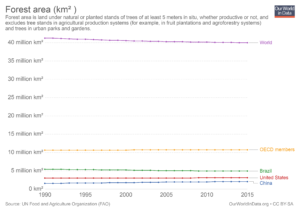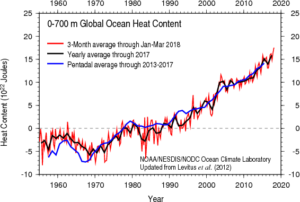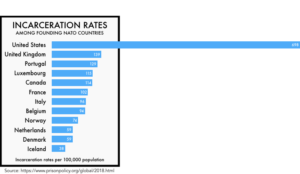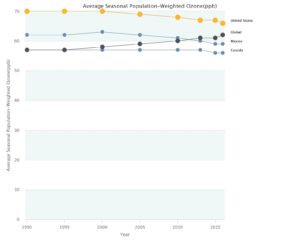 Our World in Data answers the question with an interactive chart of forest area by country and regions from 1990 to 2015. In that time period the world has lost 1.29 million square km of forest area (41.28 to 39.99). On the other hand, the U.S. and China both increased forest area by 0.08 (3.02 to 3.1) and 0.51 (1.57 to 2.08 – a 32% increase) msk respectively, while Brazil lost 0.53 msk (5.47 to 4.94). As always with Our World in Data, you can download charts (as we did here with our selected countries and regions) and the data.
Our World in Data answers the question with an interactive chart of forest area by country and regions from 1990 to 2015. In that time period the world has lost 1.29 million square km of forest area (41.28 to 39.99). On the other hand, the U.S. and China both increased forest area by 0.08 (3.02 to 3.1) and 0.51 (1.57 to 2.08 – a 32% increase) msk respectively, while Brazil lost 0.53 msk (5.47 to 4.94). As always with Our World in Data, you can download charts (as we did here with our selected countries and regions) and the data.
Why are forest important? The USDA Forest Service Ecosystem Services page is a starting point to learn more.
Healthy forest ecosystems are ecological life-support systems. Forests provide a full suite of goods and services that are vital to human health and livelihood, natural assets we call ecosystem services.
Many of these goods and services are traditionally viewed as free benefits to society, or “public goods” – wildlife habitat and diversity, watershed services, carbon storage, and scenic landscapes, for example. Lacking a formal market, these natural assets are traditionally absent from society’s balance sheet; their critical contributions are often overlooked in public, corporate, and individual decision-making.
In particular, forests play a role in climate change. Learn more and some basic science from the FAO Forests and climate change Carbon and the greenhouse effect
Is math involved in modeling forest? Yes, The Smithsonian’s National Zoo & Conservation Biology Institute article Using Mathematical Models to Save Forests (3/27/2018) provides one example:
In collaboration with partners from universities in the western U.S., South America and New Zealand, Smithsonian scientists have developed a mathematical model to help understand why certain landscapes are especially vulnerable to losing their forests and the species that rely on them, while others are more resilient.









